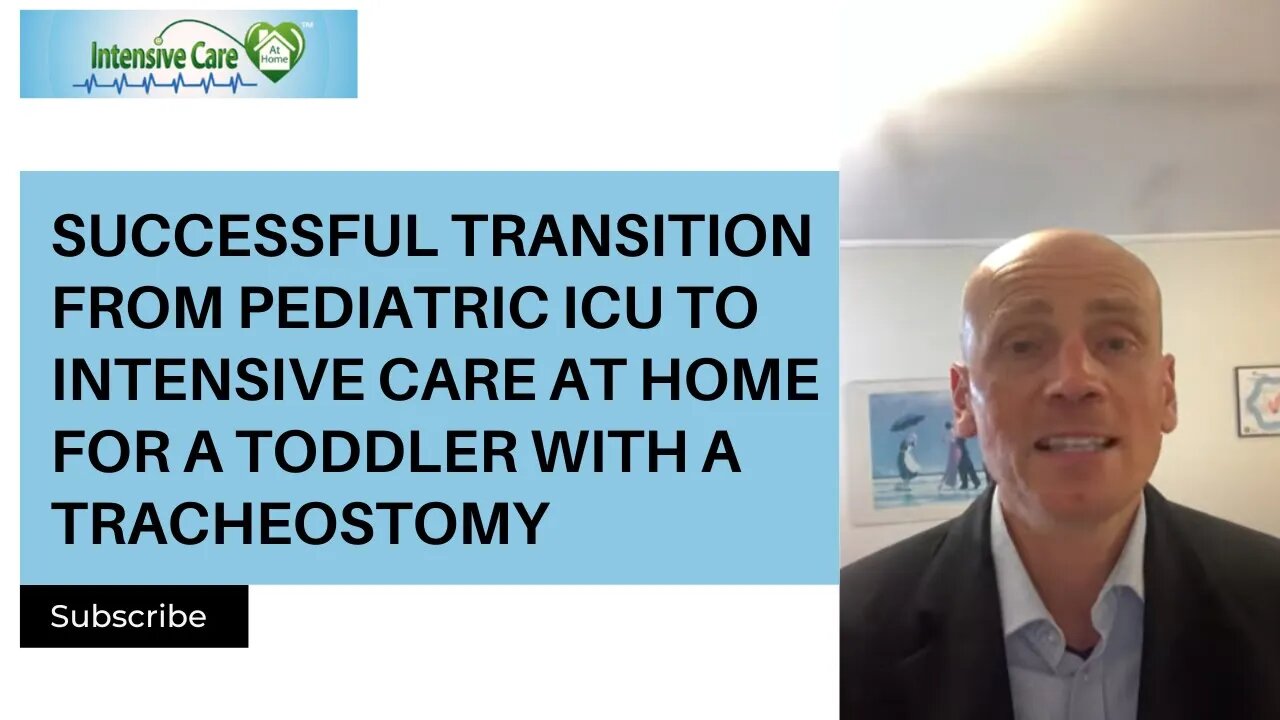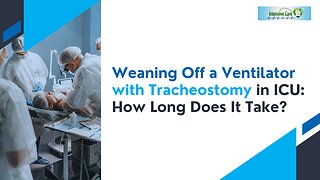Premium Only Content

SUCCESSFUL TRANSITION FROM PEDIATRIC ICU TO INTENSIVE CARE AT HOME FOR A TODDLER WITH A TRACHEOSTOMY
CASE STUDY: SUCCESSFUL TRANSITION & BETTER STANDARDS OF CARE FROM PEDIATRIC ICU TO INTENSIVE CARE AT HOME FOR A TODDLER WITH A TRACHEOSTOMY
Call directly 24/7
+1 415-915-0090 USA/Canada
+44 118 324 3018 UK
+6141 094 2230 Australia
Email support@intensivecarehotline.com
Get 1:1 consulting and advocacy
1:1 phone counselling
http://intensivecarehotline.com/one-on-one-counselling/
Become a member for families of critically ill Patients in Intensive Care
https://intensivecarehotline.com/intensivecaresupport-org-membership/
Immediate action steps http://intensivecarehotline.com/take-control-take-charge/immediate-action-steps/
https://intensivecareathome.com
And if you need a medical record review, click on the link and we can help you with reviewing your loved one’s medical records while they’re in ICU.
https://intensivecarehotline.thrivecart.com/review-of-medical-records/
Facebook Page: https://www.facebook.com/ICUhotline
Twitter: https://twitter.com/icuhotline
#icu
#intensivecare
#criticalcare
This is a case study of an ex-premature baby, now a toddler, who went home with tracheostomy after weaning from CPAP in hospital after prolonged hospital and initial NICU and then PICU stay through Intensive Care at Home.
Successful Transition & Better Standards of Care from Pediatric ICU to Intensive Care at Home for my Toddler with a Tracheostomy.
MEDICAL BACKGROUND:
This intensive care at home client was an ex-prem baby (24+5/40). CLD. Difficulties with weaning from CPAP led to further investigations, revealing tracheomalacia/tracheobronchomegaly requiring a tracheostomy.
No oxygen required.
Speaking valve: tolerated during day when awake under direct supervision for short periods.
Overnight CPAP ceased following sleep study. PDA resolved and small ASD. Difficulties with feeding and vomiting. Nasogastric tube feeding.
Findings from the Allied health team assessment indicated that the patient presents with global developmental delay characterized by delays in gross and fine motor skills, communication, and cognition compared to children of a similar age. This can be explained by both the prematurity and prolonged hospital stay due to other complex medical and surgical issues.
Hx began having seizures day 3-5 of life (bilateral jerking movements) requiring multiple AEDs to control.
EEG: focal seizures (right), background mildly dysmature for age. Seizures generalised. Phenobarbitone ceased. MRI Brain: structurally normal, normal white matter volume.
Baseline assessment – RR 32-50 bpm, Sp02 95-100% in RA normal suctioning requirements: daytime —30 minutely, overnight minimal. Bradycardia at times during sleep down to 70-75 bpm. Patient was discharged from Cardiology. An ECG and ECHO were performed at this time. Doctor approved for Iow HR alarm on oximeter to be changed from 85 bpm to 65 bpm.
Feed tolerance is an ongoing issue for patient. It is not unusual to have multiple small vomits per day, especially following a cough. On NGT feeds: 7 bolus feeds per day administered via pump over (Fortified Neocate Gold). Exploring oral purees and sipping thin fluids. No issues on full enteral feeds. Previous borderline hypoglycaemia (never below 3mmoI/L) after. Allergies: Cow’s milk protein and soy. On esomeprazole. Lower GI contrast study. NAD.
Client went home with tracheostomy after weaning from CPAP in hospital after prolonged hospital and initial NICU and then PICU stay.
The client was 12 months old when going home.
Our intensive care at home nursing team was managing the child overnight for 6 months until the child was ready for tracheostomy decannulation.
Our nursing team where we employ hundreds of years of intensive care and paediatric intensive care nursing experience combined was able to transition the child home from paediatric intensive care to an intensive care at home environment without any lowering of care standards.
Our clients get the same or better standards of care at home compared to an intensive care (ICU) environment, because clients can be in control of their routine and their wishes.
They can sleep at night in the comfort of their own home, whereas in intensive care it’s very noisy.
Also, our client’s family members also report to get some sleep at home because they know they have intensive care nurses that are comfortable with ventilation and tracheostomy...
Continue reading at: https://intensivecareathome.com/successful-transition-better-standards-of-care-from-pediatric-icu-to-intensive-care-at-home-for-my-toddler-with-a-tracheostomy/
-
 22:37
22:37
Intensive Care at Home
2 days agoWeaning Off a Ventilator with Tracheostomy in ICU: How Long Does It Take?
71 -
 LIVE
LIVE
The Charlie Kirk Show
16 minutes agoChicago Next! + The Blue Slip Problem | Sen. Tuberville, Alex Clark | 8.25.2025
2,501 watching -
 DVR
DVR
Benny Johnson
2 hours ago🚨Trump LIVE Now: Signs Executive Order ENDING Cashless Bail | Dem Cities PANIC, Which City NEXT?...
14.5K21 -

The White House
3 hours agoPresident Trump Signs Executive Orders, Aug. 25, 2025
6.6K11 -
 LIVE
LIVE
The Mel K Show
56 minutes agoMORNINGS WITH MEL K - Starving the Globalist Funded Color Revolution in America 8-25-25
472 watching -
 UPCOMING
UPCOMING
The Shannon Joy Show
2 hours ago🔥🔥Stressflation Incoming - Coffee Up 25% Veggies Up 40% As Trumps Tariff Taxes Detonate On American Families.🔥🔥
152 -
 LIVE
LIVE
LFA TV
16 hours agoLFA TV ALL DAY STREAM - MONDAY 8/25/25
4,968 watching -
 UPCOMING
UPCOMING
Grant Stinchfield
3 days agoDemocrats Try to Turn California Into Predator Playground with Proposed "Child Predator Dream Bill"
1.1K -
 1:01:13
1:01:13
VINCE
3 hours agoWhy Does This Mayor Enjoy Watching His City Burn? | Episode 110 - 08/25/25
130K80 -
 2:59:41
2:59:41
Wendy Bell Radio
7 hours agoAGENTS OF DECEPTION
40.4K103